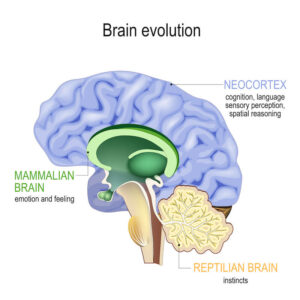We’ve all been in stressful situations where we have experienced shortened breath, a racing heart, jumbled thoughts, and maybe even felt tiny beads of sweat trickling down our back.
It may sound like I am talking about participating in a marathon, but these are also all common experiences felt during moments of intense emotional dysregulation.
Think back to your last job interview, a time you had a disagreement with a colleague, a time you had to make a public speech, or back even further to when you were a kid and someone snatched your favorite toy right out of your hands. Chances are, you were experiencing some emotional dysregulation during all of those times.
Maybe all of these situations didn’t or don’t create HUGE reactions in you, but the point is that we are all constantly moving in and out of states of regulation. We are all riding the rollercoaster of life and emotional regulation skills can help us when the rollercoaster is climbing up a hill or racing down it!
What is Self-Regulation?
Our brain has “safety features” that automatically kick in during times of heightened stress or fear. Those features are what we refer to as Fight, Flight and Freeze. Our body jumps into action and may begin to fight the danger or perceived threat, or send us running away from the danger as we suddenly discover unfound speed, or cause us to stand absolutely still like a statue.
 This is how our body tries to naturally regulate itself (shift to “positive emotions”) and ensure that we stay safe. But being able to control or self-regulate our own bodies and minds in those moments right after we recognize what has happened requires a whole other set of skills and awareness. So what exactly does it mean to be able to self-regulate?
This is how our body tries to naturally regulate itself (shift to “positive emotions”) and ensure that we stay safe. But being able to control or self-regulate our own bodies and minds in those moments right after we recognize what has happened requires a whole other set of skills and awareness. So what exactly does it mean to be able to self-regulate?
To put it simply, self-regulation is being able to “regulate” or control and manage one’s feelings, thoughts and behaviors. It is “control of oneself by oneself” (Ackerman, 2018, as cited by Bell, 2016) from emotional dysregulation to emotional regulation.
One of the most common catch phrases we might hear related to this is “Just calm down”. Sounds easy, right? But how exactly do we do that?
In order to really master self-regulation, we need to better understand the types of self-regulation and emotional dysregulation and what exactly happens in our brain when we are dysregulated.
Types of Regulation
Self-regulation consists of two integral parts of what makes us human: Our behaviors and our emotions.
Behavioral self-regulation refers to controlling our behavior regardless of our thoughts and feelings. For example, dragging yourself to the gym when you don’t want to go or withholding yourself from throwing something at someone when they have made you mad. This is a basic principle and social skill that all parents try to teach their toddlers. No parents want to deal with that fun debacle, but more on that later!
On the other hand, emotional self-regulation deals with gaining control over our emotions. Let’s use the previously mentioned example of giving a public speech or presentation. You have probably practiced self-regulating your emotions by telling yourself, “You can do this, just breathe. It will be over in 10 minutes”. Parents of toddlers will also understand the necessity of emotional self-regulation which eventually evolves into social skills!
What is Happening in the Brain?
Knowing what happens in our brain during those examples of dysregulation provides us with a better understanding of how the regulation of emotions and behaviors can be impacted at various stages of development and life.
The “triune” or three part brain model breaks down the different parts of our brain and how each area contributes to our internal state of regulation. There are loads of images on Google to depict this model and they can be helpful to use when trying to teach young children how our brain works when are having big feelings that lead to emotional dysregulation. The triune brain model consists of the Reptile brain (the brainstem), Mammalian brain (limbic system) and the Rational brain (neocortex).

The reptilian brain is where our body’s basic vital functions are controlled – things like our body temperature, breathing, heart rate and sense of balance. The brainstem is the first part of the brain to develop and is already “online” at birth. These basic functions are all things our baby’s brains are doing for them the first second they are welcomed into the world! This part of the brain is called reptilian because reptiles do not need emotions the same way that humans do. Reptiles are very instinctual and need only fulfill their daily needs of hunting, eating, sleeping and breathing to ensure that they live.
Next up is the mammalian brain or the limbic system. This is where we make decisions, perceive emotions and threats, and record our memories. Mammals are the unique and wonderful creatures that get to experience emotions; the good, the bad and the ugly!
The last part is the rational brain or the neocortex. This is where we reason, rationalize, utilize logic, and understand language. In other words, this is our thinking brain and the part that makes each of us unique (Steward, 2020). According to the National Institute of Mental Health (2023), the neocortex is not completely done developing until our mid-20s. Just think about that the next time you question why your child or teen can’t think “rationally” or master their facial expressions or regulation of emotions. That part of their brain is literally under construction! So we need to proceed with caution and patience.
All these parts of the brain are connected and in order for us to be able to think calmly and rationally. We need each part to be regulated properly so that it can communicate with the other parts.
Utilizing the acronym H.A.L.T. is an easy way to start at the bottom and work our way up. H.A.L.T. stands for Hungry, Angry, Lonely, and Tired. If our basic needs are not met we cannot be our best selves!
H.A.L.T. goes back to how we raise and approach infants in the early years of their life. If a baby is cranky and crying endlessly, we usually start by checking the clock to see when the last time they ate or slept was. We think “maybe they just want to be held and get cuddles from momma or dada”.
Adults themselves usually apply this same mentality to check in with their own mood and needs. Let’s be real, we all have experienced being hangry at some point in time! I think the Snickers slogan says it best, “You’re not you when you’re hungry!”
The Self-Regulation Cycle
We are in a constant cycle of emotional regulation, whether we are aware of it or not. It starts with a situation or event that happens which creates a cascade of thoughts, feelings, actions, and emotional responses that impact our overall response to that situation/event.
Learning self-regulation skills helps us mitigate our negative thoughts, feelings, and reactions. To some this principle might be better understood through a common modality of therapy: Cognitive-Behavioral Therapy. This common therapy approach is rooted in the fact that our thoughts impact our feelings which impact our actions. If we can change our thoughts, we can change how we feel and therefore how we act. This takes practice!
Self-Regulation Skills: Mindfulness & Cognitive Reframing
 Some ways in which we can practice and strengthen our ability to self-regulate are by incorporating mindfulness and reframing our thoughts. Mindfulness is a term that has surged in popularity and is defined as “the basic human ability to be fully present, aware of where we are and what we’re doing, and not overly reactive or overwhelmed by what’s going on around us” (Cherry, 2023).
Some ways in which we can practice and strengthen our ability to self-regulate are by incorporating mindfulness and reframing our thoughts. Mindfulness is a term that has surged in popularity and is defined as “the basic human ability to be fully present, aware of where we are and what we’re doing, and not overly reactive or overwhelmed by what’s going on around us” (Cherry, 2023).
Mindfulness is practiced through a variety of exercises such as yoga, deep breathing, and guided meditations. I encourage all of my clients to try a few different types of mindfulness exercises more than once before they say, “That just doesn’t work!”. Mindfulness is a learned practice and requires focus in order to regulate our breathing, direct our attention to the present, and become aware of how our body feels in space. There are loads of apps and YouTube videos that walk you through guided mindfulness meditations. Some apps that I usually recommend are Calm, Waking Up or Headspace (which are all linked on the Resources > Apps page of our website).
Practicing mindfulness starts with being intentional with carving out some private time to get comfortable, focus on your breathing, and notice your thoughts. When we learn to effectively practice and incorporate mindfulness, it can contribute to an increase in immunity, a decrease in stress, and improved sleep (Cherry, 2023).
Another skill for emotional self-regulation is cognitive reframing, which is really the practice of being able to change our automatic thoughts from negative to positive or to more realistic ones.
Let’s use an example of a friend canceling plans at the last minute. This is a very common situation that comes up in my sessions with teens and causes them to have strong emotional responses. A thought or question that is generally posed by my clients is “Why is my friend mad at me?”.
My clients tend to immediately go to a place of hurt or sadness. Instead of feeding into these negative emotions and thoughts that their friendship is on the rocks and their friend hates them, I encourage my teens to try and reframe their thoughts into something different and more realistic, which can increase client’s distress tolerance, as well as provide hope that some positive thinking might surface.
For instance, maybe the friend had an issue with finding a ride, maybe their parent(s) had to work, or maybe they had a family emergency and didn’t feel like sharing. I also flip the script and ask them if they canceled plans last minute with a friend, would they do it because they hated their friend? Likely, the answer is no. Things happen and even if plans are canceled, our friends are still our friends! If there was more to the story, it is up to that friend to communicate that with us. If there is a pattern of a particular friend canceling on my client, our conversation will look a bit different and include more evaluation and skill-building related to how to handle the future conversation with that friend.
Reframing our thoughts sounds simple in theory but I recognize that it takes a lot of practice and effort to override our automatic negative thoughts. An idea for how to encourage ourselves and our teens to practice this is to use the A.N.T. (automatic negative thoughts) and P.O.T.s (planting optimistic thoughts) metaphor: The little tiny A.N.T.s that crawl around us are our automatic negative thoughts, but we need to provide our A.N.T.s with some pretty P.O.T.s of plants and flowers. This symbolizes the idea of planting optimistic thoughts. Practice this the next time you notice your A.N.T.s scurrying about and overriding the beauty of our P.O.T. plants. We are seeking to balance thoughts in our brains and give others the benefit of the doubt more often.
Why is Self-Regulation Important?
Self-regulation is how we learn to navigate our daily lives and manage threats. This is taught and modeled to us early on from our caregivers. When we are young, we look to our caregivers to let us know if things are okay. As we think back to the three part model of the brain, the last part to develop is our “rational” or thinking part of our brain. Children do not have the ability to logically think through a perceived threat, but rather they detect it and look to their caregivers to send them messages regarding their safety.
For instance, a child falls down and skins their knee, and they immediately look to their caregiver for a reaction. Are they hurt? Is it bad? Should they cry? All of this is conveyed on a caregiver’s face. If something happens and you look at people around you and they all have terrified and shocked facial expressions, you don’t even think about it – you immediately jump to a place of terror and know whatever has happened it must not be good! This might create an emotional outburst, even if the pain is not tremendous, purely because the child is reacting to the regulation in adults in their life (or lack of regulation).
 Working on regulation in children and adolescents is a big part of my job as a therapist. I work with the child and parent(s) to learn healthy ways of coping and regulating (improving distress tolerance) so that they can both navigate those difficult situations and negative emotions that inevitably happen in life. A study conducted by Rodriquez et al. found that students who practiced self-regulation had “greater satisfaction with life and fewer emotional or behavioral problems and fewer problems in peer relationships” when they were able to practice self-regulation, as it expanded their ability to maintain their focus and allows others to also feel comfortable around them.
Working on regulation in children and adolescents is a big part of my job as a therapist. I work with the child and parent(s) to learn healthy ways of coping and regulating (improving distress tolerance) so that they can both navigate those difficult situations and negative emotions that inevitably happen in life. A study conducted by Rodriquez et al. found that students who practiced self-regulation had “greater satisfaction with life and fewer emotional or behavioral problems and fewer problems in peer relationships” when they were able to practice self-regulation, as it expanded their ability to maintain their focus and allows others to also feel comfortable around them.
A book I that recommend the parents of many of my clients read is “The Whole Brain Child” by Dan Siegel. This book highlights the importance of caregivers remaining regulated and managing emotional reactivity in order to foster emotional regulation in children. It provides concrete tools to use when dealing with overwhelming moments of behavioral and emotional dysregulation.
Some ways in which adults can help themselves through strong emotions around their kids is to stay regulated by taking deep breaths, using a calm and soft tone of voice, and slowing their speech down. All of these actions send the message to the child that they are in a calm and safe environment and that they are not in danger, which helps the child’s internal systems begin to calm down and regulate (avoid emotional reactivity). It was found that “poorer early regulatory abilities were a significant predictor of a range of later mental health disorders, conduct disorders, and anxiety disorders. Similarly, problems with maintaining attention and controlling emotions or behavior in early childhood also had an impact on the likelihood of suffering from anxiety or depression in adolescence” (Rodriquez et al., 2022).
How to Measure our Self-Regulation:
Are you curious to know more about how well you maintain your self-regulation? There are loads of free self-regulation questionnaires online. These can be a fun tool to show us where we might need a bit more practice in various aspects and areas of our life. Here is a link to a shorter 63 question survey:
If you want to take a deeper dive into self-regulation you can visit The Zones of Regulation. Although this is a curriculum created and utilized in school settings, there are numerous resources to help teach people of all ages what it really means to be regulated.
Lifelong Learning
Learning the art of physical and emotional regulation is a lifelong journey and getting good at those self-regulation skills takes time and practice! Stressful situations are an inevitable part of everyday life, but emotion regulation skills can help us get through them so that we can savor and appreciate the positive moments in life.
Blog written by Sentier therapist Bridgett Brye, MSW, LICSW.
Sources
Ackerman, C. (2018, Jul 3). What is self-regulation? Positive Psychology. https://positivepsychology.com/self-regulation/#what-self-regulation
Cherry, K. (2023, Oct 6). What is mindfulness meditation? Very Well Mind. https://www.verywellmind.com/mindfulness-meditation-88369
National Institute of Mental Health. (2023). The teen brain: 7 things to know. NIH. https://www.nimh.nih.gov/health/publications/the-teen-brain-7-things-to-know#:~:text=The%20brain%20finishes%20developing%20and,the%20last%20parts%20to%20mature.
Rodríguez, Susana & González- Suárez, Rocío & Vieites, Tania & Piñeiro, Isabel & Díaz-Freire, Fátima M.. (2022). Self-Regulation and Students Well-Being: A Systematic Review 2010–2020. Sustainability. 14. 10.3390/su14042346.
Steward, N. (2020, April 15). Understanding trauma: what it is and how it shows up [PowerPoint Slides]. Continued. https://www.continued.com/social-work/ceus/course/understanding-trauma-part-1-what-15











